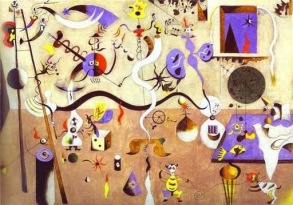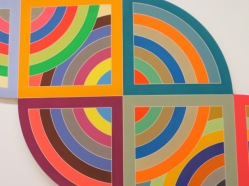A (very) brief history of abstract painting from 1910 to Post-modernism
In attempting to understand contemporary abstract art, I found it important to look at its precedents in history. This is a very quick tour.
It can be argued that all painting involves abstraction – abstracting from the “reality” that confronts the artist. But what we commonly accept to be abstract painting began in the early 20th century (though foreshadowed by the Impressionists and the Post-Impressionists, and certainly by JMW Turner, with their prioritising of light, form and colour over representational accuracy; and now by Georgiana Houghton, whose beautiful abstract “spirit” paintings of the 1860s and 70s have come to light). The way was also paved by the likes of the Fauvists, with their non-naturalistic colour, the Art Nouveau movement with its stylised shapes, the German Expressionists of Die Brucke, and the Cubists, with their rejection of traditional perspective and the deconstruction of objects; however such painters were still “representing” objects and scenes, however obscurely.
Most of the early abstract art movements were idealist; they believed their art to be transcendental and expressive of humanist and spiritual universal principles. After the horrors of World War abstract art was also felt to have a role in creating a better world – though some who had veered towards abstraction began to use their art for more political purposes. Although art history categorises the various movements, they are better regarded as tendencies, which overlapped, inspired one another and often had members in common. Though mostly short-lived, these movements have influenced abstract art (as well as other aspects of Western culture) until the present.
Wassily Kandinsky was possibly the earliest pioneer of true non-figurative art. He became a leading member of Der Blaue Reiter, another German Expressionist grouping (which included for example Paul Klee); like a number of other artists of the period, he was influenced by Theosophy and the link it made between the emotional/spiritual and colour, shape and line – in contrast to the intellectual approach of Cubism. He went on to become a teacher at the Bauhaus.
1  2
2 
Squares with concentric circles 1913 On white II 1923
Other contemporaries were the Orphists (the most famous exponents being Robert and Sonia Delaunay), with their exploration of the optical and psychological aspects of colour (causing a split with the Cubists and their restricted palette)
Delaunay Le Premier Disque 1912-13 R.Delaunay Rhythme No.1 1938
In Russia, Malevich developed Suprematism as a way of focusing on pure form, without any references from the natural (or social/political) world; the use of geometric shapes culminated in his famous Black Square of 1915 and his white-on-white paintings of 1918. However with the Russian revolution, such painting fell out of favour. Another movement took precedence: Constructivism, which also emphasised geometrical shapes, but for utilitarian purposes; it migrated to design and became co-opted for revolutionary propaganda.
Malevich Suprematism 1915 Malevich Black Square 1915 Rodchenko Construction 1918
From Italy came the Futurists, with their love of urban modernity, machines, speed and change – including violence and a macho attitude; one example was Giacomo Balla. Closely linked to the Futurists (though hostile to them) were the English Vorticists (e.g. Wyndham Lewis), also characterised by Cubist fragmentation and a focus on urban environment and machinery.
Balla Abstract speed + sound 1913-14 Lewis Workshop 1914-15
From the Netherlands there was the De Stijl group of “neo-plastic artists”, which included Piet Mondrian. The emphasis was on primary colours and geometric shapes, where the universal laws of harmony could be found; they went beyond fine art to design furniture etc on the same lines.
Mondrian Composition No.II 1920
Concerned rather more with mocking bourgeois, materialistic society and challenging the status quo than with transcendentalism and harmony were the Dadaists – though more through three-dimensional works (“ready-mades”) and performance than painting. Jean Arp was most famous for his (apparently) randomly-arranged collages. Dadaism was overtaken by Surrealism, with its associations with the unconscious, dreams, automatism and incongruity – the antithesis of rationality and with a revolutionary edge. Two leading painters were Salvador Dali and Jean Miro, who might be considered figurative, although their presentation of objects was entirely abstract.
11. Arp Untitled (Collage with Squares Arranged according to the Laws of Chance) 1917.
12. Miro Harlequin’s carnival 1924-5
13. Dali The accommodations of desire 1929
With Abstract Expressionism – a very broad term for a wide range of artists and tendencies which came to prominence in the 1940s and 50s – the focus of abstract art shifted to America, although its roots lie in earlier European movements, especially Cubism and Surrealism, imported to a large extent by those fleeing Europe. What they had in common was the desire to express profound inner emotions and universal themes, a strong individuality, and an emphasis on paintings as two-dimensional, non-representational flat surfaces (see Research page on Formalism and Zombie Formalism). There were two main tendencies: gestural abstraction (sometimes called action painting), as typified by Jackson Pollock, and Colour Field painting, where large areas of colour were used to envelope and transport the viewer – as with Mark Rothko. Although allied with Colour Field Painting, Hard Edge Abstraction moved away from what they saw as the romantic notions of Expressionism – for example Frank Stella. There are so many artists but these three will have to suffice here as perhaps the best-known representatives of their genre. The resemblance between Delaunay and Stella, say, belies their intention: the one spiritual, the other a concern with the materiality of paint which expresses nothing but itself.
14 Pollock Number One 1950 15 Rothko Orange, red, yellow 1961 16 Stella Harran II (detail) 1967
Colour Field and Hard Edge veered into Minimalism, which arose in the 1960s as a reaction against emotionality and symbolism, and in pursuit of materiality and anonymity. Boundaries became blurred between painting and sculpture, and there was a renewed interest in Constructivism, ready-mades and industrial materials. The “subject” of painting was indeed minimal; certainly any form of figuration was seen as a distraction from the “painting-ness” of the painting. The painter given here is Robert Ryman, as he is my favourite from this period; he has spent the last 50 years exploring the different ways that basically white squares can be created, using different supports, materials (including those incorporated into the paintings such as tape), application methods and wall mountings. I have also included Brice Marden, another favourite from this period; he later moved to a completely different style, creating paintings with long sticks. These two examples typify my attraction to grey and white, which has a long tradition within painting.
17  18
18 
Ryman Mayco 1965 Marden Grove Group III 1973
Also in the 1960s there was the development of Op Art, and its preoccupation with the nature of perception and the optical effects that could be created by painting. It was quite short-lived as a movement but was taken up enthusiastically by fashion designers and others. Bridget Riley is a typical example.
Riley Cataract 3 1967
(I have not covered other movements here such as Pop Art as they brought figuration back and are therefore not concerned with abstraction in it pure form.)
Neo-expressionism brought action painting and the expression of emotion back into abstract painting, as a reaction to minimalism and conceptual art – and also in reaction to the identity politics of post-modernism, with which was contemporaneous during the 1970s. It was popular especially in Germany, where Gerhart Richter was a leading figure (and a personal favourite of mine); in America were artists like Jean-Michel Basquiat.
Basquiat Glenn 1984 Richter Abstraktes Bild 1994
All of which brings us up to Post-Modernism which is often held to start from the late 1970s although there are plenty of precedents – Duchamp’s urinal would not have been out of place in a post-modernist exhibition. Put very simply, grand narratives and manifestos were rejected, as was the idea that there was a “correct” kind of art, which put forward universal ideas about humanity. Formalist aesthetics were out. There was an anti-authoritarianism (which had actually started in the 60s), and an emphasis on identity politics; critiques of both the society which was the subject of the art, and of the art world itself, were made from a point of view based on gender, race and sexuality. Left-wing politics predominated, with a critique of capitalism (and the art market). This was contrary to formalism which held that there was nothing beyond the artwork itself. Art was characterised by pastiche, appropriation and deconstruction.
Images retrieved from
1&2 http://www.wassilykandinsky.net/
3&4 https://en.wikipedia.org/wiki/Robert_Delaunay
5&6 http://www.wikiart.org/en/kazimir-malevich/suprematism-1915
7 https://nz.pinterest.com/pin/569142471630204800/
8 https://en.wikipedia.org/wiki/Futurism
9 http://www.tate.org.uk/art/artworks/lewis-workshop-t01931
10 http://www.piet-mondrian.org/composition-number-2.jsp
12 http://www.tate.org.uk/context-comment/articles/miro-london
13 http://www.metmuseum.org/toah/works-of-art/1999.363.16/
14 http://www.jackson-pollock.org/
17 http://www.saatchigallery.com/aipe/robert_ryman.htm
19 https://en.wikipedia.org/wiki/File:Riley,_Cataract_3.jpg
20 http://www.wikiart.org/en/jean-michel-basquiat/glenn
21 http://www.extravaganzi.com/gerhard-richter-abstraktes-bild-809-4-sold-for-34-million-and-broke-the-record-for-a-living-artist/
 4
4
 6
6  7
7 











